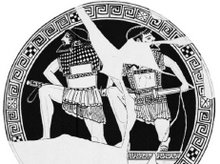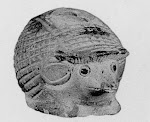“Footwork in Ancient Greek Swordsmanship”
Brian F. Cook, Metropolitan Museum Journal, Vol. 24 (1989), pp. 57-64
In this paper an overhead strike is discussed. With minor variations it appears as below.

From the paper:
“The so-called "Harmodios blow" studied by Shefton, who coined the useful term by which it is now fairly generally known. This is a slashing movement named for the action of Harmodios in the marble statuary group of the Tyrant-slayers best known from a Roman copy in Naples. The moment most frequently represented is the point of stillness when the sword- hand has been raised head-high with the sword pointing backward over the shoulder in readiness for a downward slash. The blow may be delivered either forehand (Figure 1) or backhand (Figure 2). Philip Lancaster, of the Department of Edged Weapons at the Tower of London, who kindly gave advice on some practical aspects of swordsmanship, pointed out that this movement would be hazardous under normal combat conditions: not only is there some danger that it would put a swordsman off balance, but the action would also leave the sword-arm unprotected and vulnerable. B. B. Shefton had already noted that the sword when raised could not be used for parrying, and that in close combat the blow therefore required careful timing. It would have been particularly dangerous for a Greek hoplite in leaving the armpit exposed above the edge of the cuirass.' A further disadvantage of the Harmodios blow is that it was less effective than a thrust against a well-equipped opponent: it would probably have been resisted even by a padded linen corselet, which would have been vulnerable to a thrust, and would certainly have been ineffective against a metal cuirass." In combat, then, the Harmodios blow can only have been a desperate measure, employed when the vulnerability it imposed was outweighed by a greater danger.”
“Finding no examples of the use of the Harmodios blow before the closing years of the sixth century B.C.,' Shefton connected it with the introduction of the spatulate sword, a more versatile weapon than the straight-edged sword, which is most effective in an underhand stabbing or thrusting movement. It is around the same time that warriors began to be represented in Attic red-figure in a stance that, al- though it soon became conventional, may reflect the kind of simple drill-movement for which no literary evidence survives. The movement is in fact so simple that no specific comment was made by ancient authors: like so many minor details of life, it was too familiar at the time to call for explanation.”
Now the above may all be true, but the Harmodios may not have been so dangerous and unlikely as thought by the authors above. In fact the Harmodios blow might be one of the few strikes available to men who are standing in synaspismos, close order with overlapping shields. If men are in close as I have described previously, shield to shield, then the right arm needs to not only strike in this fashion, but also move in this way to ward the head. I have been experimenting with how one could fight in so close, with only the raised right arm given freedom of movement. The answer is very much like the harmodios blow. Better yet would be to adopt a shorter blade like the Spartans may have done.

An interesting note on swords is that the sword (xiphos) is slung in a sheath high under the left arm, almost like a shoulder-holster for a pistol. I have been told by hoplite reenactors that this makes drawing the sword much easier in the confined space of a fighting phalanx. The manner of hanging the sheath may thus be yet another feature of the panoply designed for fighting in crowded conditions.





8 comments:
The points you make are valid. I think that there can be a misunderstanding with a position such as this, that it's an ineffective position to parry/defend. This generally comes from the idea that a parry is a static position rather than an active one. In reality, the best form of defence is attack, i.e. one actively redirects an attack, by attacking it. This works against both sword and spear wealding opponents.
Welcome Jonathan, good points. I have seen video of Mensur fencers using parries similar to the around the head movements described above to ward the head at very close range- albeit with longer "schlagers."
Yes a schlager ccan be parried that, way, however the nature of the Mensur cuts is quite different. The power you can easily generate with the kinds of sowrd the Hoplite woul dbe using woul make me very uncertain os topping one with a static parry.
I would suggest that this postition, makes for a good "cocked" position from which to strike from and return to, keepig the arm reasonably out of the way of enemy attacks until you strike, and you can get a good snapping strike from the position, which easily rechambers itself.
Nice blog site!
another piece of interest
Saw this of reconstructed Greek boxing
http://www.youtube.com/watch?v=47jmOxzux-8
Looking at it reminded me that I had seen a stance similar to the Harmodious on vases showing boxwers, Pankration.
Seeing it in action in the video, you see it being used as a cover, similar to tha used by modern boxwers, but here it is being used a sposition to strike down from, using the base of the fist/edge of the hand. obviously helped by the gact that they are wearing cestus.
This adds a level of economy of technique tranisition from one fighting to style to another.
Jonathan
Jonathan,
Very interesting. The "cocked" position you describe is the way reenactors use axes. The hold it back on the shoulder, then snap it forward to strike. Because the Machaira was so point heavy it probably shared many properties with an axe.
The idea that one weapon style would influece another warrants more study. In the case of the cestus, it might be that a hammer blow generates more force with the added weight than a straight punch. One thing that I have learned is that the overhand strike is the strongest a man can generate. I'll do a post specifically on this and show some of the data from various studies.
a hammer blow is powerful but, he reason to use it, is IMO, for both boxing and on the battle field down to expediemcy. In boxing it comes from a block/cover postion, on the battle field it is down tot he fact that one has lttle room do employ other, more effiecient positions.
If one looks at martial systems economy of techniques is a common feature of martially sound and intergrated systems, those of Ancient Greece would not be any different IMO.
Best
JW
We'd have to define "efficient" as it applies to spears fencing positions. Holding the arm up for extended periods is of course tiring, but strikes from this position can be fast, powerful, and accurate. I am better in all three of those categoties with an overhand strike than an underhand strike. Most importantly, an overhand strike gives you a wider range of targets in a phalanx environment. You can think of a spear held underhand as analogous to a gun in a sponson, as in old WWI tanks, while a spear held overhand is more like a turret. This is made worse in a phalanx, where you have to strike above overlapping shield rims. You can do this in a "high underhand" position. Some late Roman reenactors I know do this, partially because they can choke up on their center-balanced spears by using the underside of the forearm for added support. But over the tops of overlapped shields, the overhand strike is a better option and less likely to foul your friends- moreso for the men in the second rank who have to strike over their companions.
Yes I think we are in agreement. When I said "more eficient" positions to fight from i was refereancing that we were discussing what could be done in the phalanx and the press.
Best
Post a Comment